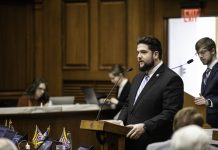Dr. Bucshon’s Statement on Governor Holcomb’s Letter on AHCA
Olivia Covington for www.theindianalawyer.com
The U.S. Supreme Court established a standard nearly 20 years ago for determining when the punitive nature of a civil forfeiture has surpassed a reasonable limit: if the forfeiture is “grossly disproportionate†to the criminal conduct in question.
In the case of State of Indiana v. Tyson Timbs and a 2012 Land Rover LR2, 27S04-1702-MI-00070, the state of Indiana argues the civil forfeiture of Tyson Timbs’ Land Rover as a fine for his drug convictions does not surpass the “grossly disproportionate†standard in United States v. Bajakajian, 524 U.S. 321, 338 (1998), because of the “gravity†of Timbs’ crime of dealing in heroin. But from Timbs’ perspective, his crime was at the “lower end of the scale,†so the forfeiture of a $40,000 vehicle as punishment for a roughly $500 drug deal is excessive.
Both the trial court and Indiana Court of Appeals agreed with Timbs’ argument, with the trial court holding that there was a statutory cap on fines of $10,000, and the appellate court ruling the $40,000 forfeiturewas unconstitutionally excessive.
During arguments before the Indiana Supreme Court Thursday, Justice Robert Rucker told deputy attorney general Justin Roebel that the Bajakajian Court established an admittedly vague standard for finding the grossly disproportionate threshold — whether the amount of the civil forfeiture is grossly disproportionate to the “gravity of the offense.†Considering how severely Indiana law treats and punishes drug crimes, Roebel said a $40,000 forfeiture would not extend past the Bajakajian standard for a heroin conviction, an offense considered particularly grave. He maintained the forfeiture of the Land Rover was not grossly disproportionate.
But David Stone, Timbs’ counsel, noted that Timbs only made two drug sales, each for about 2 grams of heroin. While dealing in drugs is treated seriously in Indiana, Stone said looking at the continuum of drug crimes, Timbs’ conduct would be categorized among lesser offenses.
Further, Stone called into question another portion of the state’s argument —Timbs admitted to predominantly using the Land Rover to drive from Marion to Richmond to fuel his heroin addiction. Stone said the state did not raise that issue as grounds for the forfeiture until after it lost in the trial court, so its argument in that regard is “too little, too late.â€
Similarly, Chief Justice Loretta Rush noted the trial court had made findings as to Timbs’ frequent use of the car to go to Richmond to purchase heroin, yet still found that the forfeiture would be excessive. But Roebel said the trial court had erred in its legal conclusions by failing to give weight to the fact that more often than not, Timbs used his car to purchase the drugs.
Further, Roebel said when Timbs raised an Eighth Amendment “excessive fine†claim, the state then moved to the Bajakajian standard, which requires an examination of surrounding criminal conduct, such as the use of the car to drive to Richmond.
When asked by Justice Geoffrey Slaughter where a bright line could be drawn to determine when a potential fine comes grossly disproportionate, Stone suggested an amount three times the value of the asset versus the potential fine. That rationale would align with the same rationale the Legislature used when determining how much can be recovered as damages in a civil action for conversion of property, Stone said.
Given the ambiguity of the Supreme Court’s directive in Bajakajian, Rucker asked Roebel why Stone’s three-times-the-value proposal could not work. Roebel noted that the value of the fine was one of many factors the Supreme Court urged courts to look at in civil forfeiture actions and repeated that the gravity of the crime should be given considerable weight.
The full oral arguments can be viewed here.




